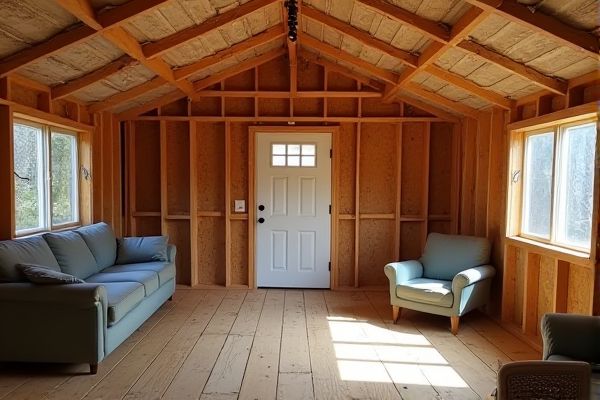
An insulated shed maintains stable temperatures by reducing heat loss and condensation, making it ideal for year-round use and protecting your tools and equipment from extreme weather. Discover the key differences and benefits that will help you choose the best option for your needs in the rest of this article.
Table of Comparison
| Feature | Insulated Shed | Uninsulated Shed |
|---|---|---|
| Temperature Control | Maintains stable internal temperature | Subject to external temperature changes |
| Energy Efficiency | Reduces heating and cooling costs | No energy efficiency benefits |
| Moisture Control | Minimizes condensation and dampness | Higher risk of moisture buildup |
| Comfort | More comfortable for extended use | Uncomfortable in extreme weather |
| Cost | Higher initial investment | Lower upfront cost |
| Durability | Improved structural longevity | Potential for faster wear and tear |
| Use Cases | Ideal for workshops, offices, and storage of sensitive items | Suitable for basic storage and seasonal use |
Introduction: Insulated vs Uninsulated Sheds
Insulated sheds maintain stable internal temperatures by reducing heat loss and condensation, making them ideal for year-round use and protecting sensitive equipment. Uninsulated sheds are more cost-effective and provide basic shelter but can experience extreme temperature fluctuations and moisture buildup. Choosing between insulated and uninsulated sheds depends on your climate, storage needs, and budget considerations.
Key Differences Between Insulated and Uninsulated Sheds
Insulated sheds feature thermal barriers like foam panels or fiberglass, significantly improving temperature regulation and energy efficiency compared to uninsulated sheds, which lack these materials and often experience extreme temperature fluctuations. Noise reduction is another major benefit of insulated sheds, making them ideal for use as workshops or studios, while uninsulated sheds offer minimal soundproofing. Moisture control and condensation prevention are enhanced in insulated sheds, reducing risks of mold and damage, unlike uninsulated versions that are more susceptible to humidity-related issues.
Energy Efficiency and Temperature Control
Insulated sheds significantly enhance energy efficiency by reducing heat transfer through walls and ceilings, maintaining a more consistent internal temperature compared to uninsulated sheds. This temperature control minimizes the need for additional heating or cooling, leading to lower energy consumption and costs. In climates with extreme temperatures, insulation prevents heat loss in winter and heat gain in summer, creating a more comfortable and protected environment for stored items or workspace activities.
Cost Comparison: Initial Investment and Long-Term Savings
Insulated sheds typically require a higher initial investment due to the cost of materials like foam panels, vapor barriers, and thermal insulation, whereas uninsulated sheds have lower upfront costs with basic construction materials. Over time, insulated sheds offer significant long-term savings by reducing heating and cooling expenses, enhancing energy efficiency, and protecting stored items from extreme temperature fluctuations. Uninsulated sheds may incur higher utility bills and increased maintenance costs related to weather damage and temperature-induced wear.
Moisture Protection and Condensation Issues
Insulated sheds provide superior moisture protection by maintaining consistent interior temperatures, which reduces the risk of condensation forming on walls and stored items. Uninsulated sheds are prone to temperature fluctuations that cause condensation, leading to dampness, mold, and potential damage to tools and materials. Installing vapor barriers and proper ventilation enhances moisture control in both insulated and uninsulated sheds, but insulation remains key to minimizing condensation issues.
Comfort and Usability Year-Round
Insulated sheds maintain a stable interior temperature, making them significantly more comfortable and usable throughout the year by protecting against extreme heat in summer and cold in winter. Uninsulated sheds often experience temperature fluctuations that can limit their functionality during harsh weather and reduce overall comfort. If you plan to use your shed regularly, investing in insulation enhances usability and ensures a more pleasant environment year-round.
Impact on Stored Items and Equipment Longevity
Insulated sheds maintain stable internal temperatures, reducing exposure to extreme heat or cold that can cause warping, rusting, or degradation of stored items and equipment. Uninsulated sheds are more susceptible to temperature fluctuations and moisture buildup, accelerating wear and potentially leading to mold or corrosion. Proper insulation extends the lifespan of tools, machinery, and sensitive materials by creating a controlled environment that protects against environmental damage.
Installation Process and Material Options
Insulated sheds require installation of thermal barriers such as foam board, fiberglass, or spray foam insulation, which involves precise fitting between wall studs and roof rafters to ensure energy efficiency and temperature regulation. Uninsulated sheds offer simpler setups using basic materials like plywood or metal panels without the need for additional layers, allowing for quicker assembly but limited climate control. Material options for insulated sheds often include vapor barriers and moisture-resistant drywall, while uninsulated sheds typically rely on single-layer exterior materials such as corrugated metal or untreated wood.
Maintenance Requirements and Durability
Insulated sheds require less frequent interior maintenance due to regulated temperatures that prevent moisture buildup and reduce the risk of mold and rot, enhancing overall durability. Uninsulated sheds may suffer faster material degradation as they are exposed to temperature fluctuations and condensation, leading to potential warping and rust. Investing in insulation extends the lifespan of the shed's structural components and minimizes long-term repair costs.
Choosing the Right Shed for Your Needs
Insulated sheds provide superior temperature control, protecting stored items from extreme heat and cold, making them ideal for sensitive equipment or year-round use. Uninsulated sheds are cost-effective and suitable for storing non-sensitive items in moderate climates. Understanding your specific storage requirements and climate conditions helps you choose the right shed to maintain your belongings' longevity and functionality.
 homyna.com
homyna.com